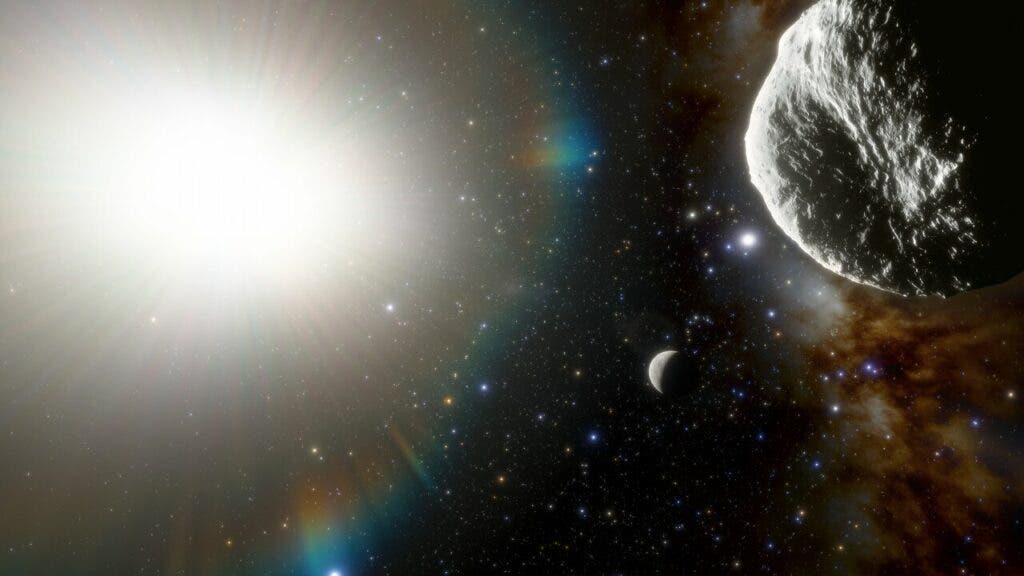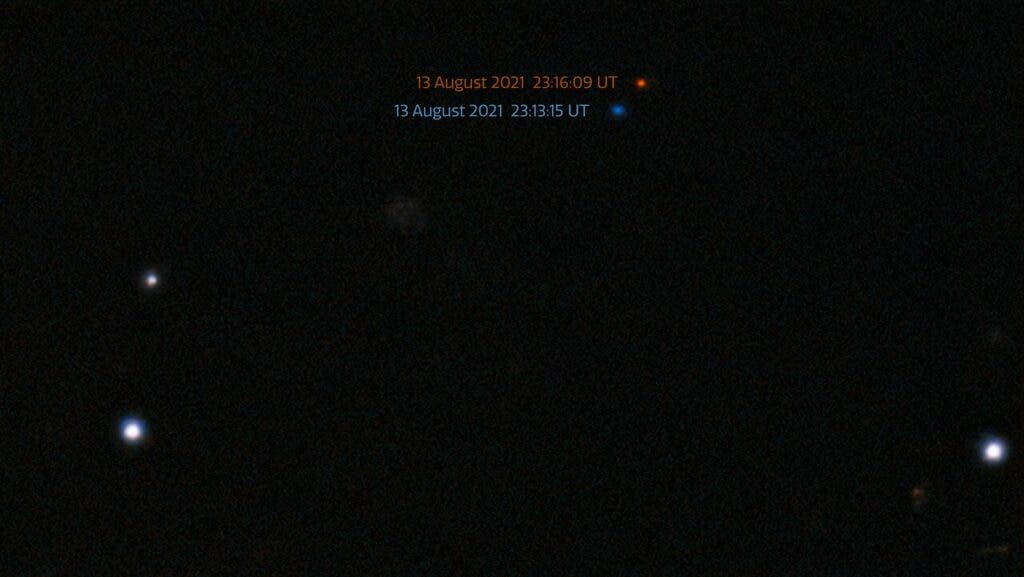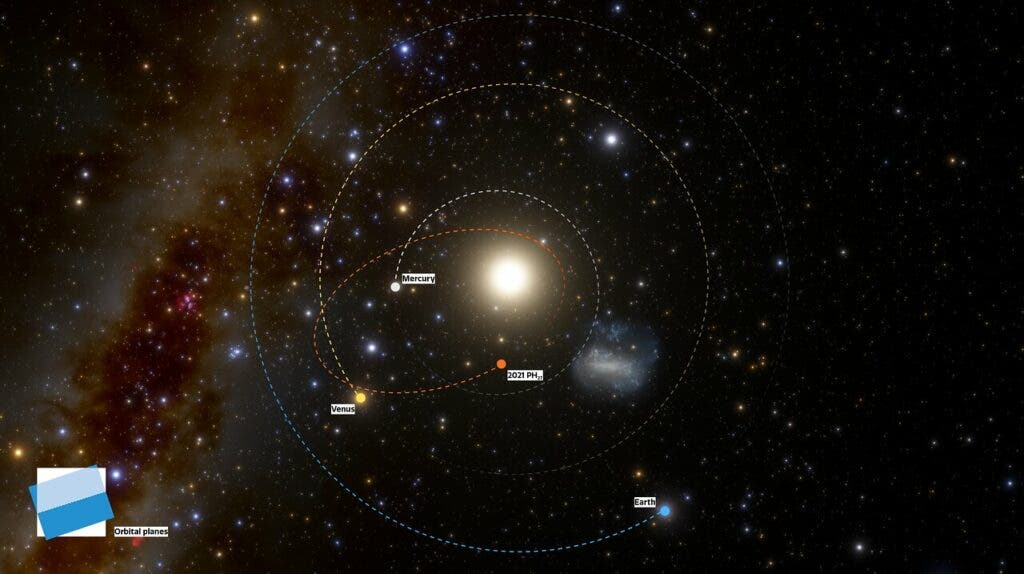Astronomers have discovered a one-kilometre wide asteroid orbiting the Sun at a distance of just 20 million km (12 million miles). Not only does this make the asteroid–currently designated 2021 PH27–the Sun’s closest neighbour, but it also means that as it completes an orbit in just 113 days, it is also the solar system’s fastest-orbiting asteroid. 2021 PH27 skirts so close to the Sun that its discoverers say its surface temperature is around 500 degrees C–hot enough to melt lead.

Scott S. Sheppard of the Carnegie Institution of Science first spotted asteroid 2021 PH27 in data collected by the Dark Energy Camera (DECam) mounted at the prime focus of the Victor M. Blanco 4m Telescope at Cerro Tololo Inter-American Observatory (CTIO), Chile. Brown University astronomers Ian Dell’antonio and Shenming Fu took images of the asteroid on 13th August 2021 at twilight–the optimum time for hunting asteroids that lurk close to the Sun. Just like the inner planets–Mercury and Venus–asteroids that exist within the Earth’s orbit become most visible at either sunrise or sunset.
The discovery was followed by measurements of the asteroid’s position conducted by David Tholen of the University of Hawai‘i. These measurements allowed astronomers to predict asteroid 2021 PH27’s future position, leading to follow-up observations on the 14th of August by DECam and the Magellan Telescopes at the Las Campanas Observatory in Chile.

These observations were then subsequently followed on August 15th by imaging made with the Las Cumbres Observatory network of 1- to 2-meter telescopes located in Chile and South America by European Space Agency (ESA) researcher Marco Micheli.
The findings were so significant that many astronomers cancelled their scheduled projects to use telescope time with a variety of sophisticated instruments to further observe the asteroid. “Though telescope time for astronomers is very precious, the international nature and love of the unknown make astronomers very willing to override their own science and observations to follow up new, interesting discoveries like this,” explains Sheppard.
What makes the discovery of asteroid 2021 PH27 so special, and of great interest to astronomers, is the fact that it belongs to a population of solar system bodies that have been, thus far, notoriously difficult to spot.
Hunting For Inner Solar System Asteroids
Interior asteroids that exist close to the Sun tend to be difficult for astronomers to spot because of the glare from our central star. This difficulty is amplified by the fact that as they get close to the Sun these objects experience intense gravitational, tidal, and thermal forces that breaks them up into smaller–thus tougher to spot–fragments.

That means tracking an intact interior asteroid could have benefits for our understanding of these objects and the conditions they experience. In particular, if there are few asteroids experiencing a similar orbit to asteroid 2021 PH27 it may indicate to astronomers many of these objects were loose ‘rubble piles.’ This may, in turn, give us a good idea of the composition of asteroids on a collision course with Earth, and crucially, how we could go about deflecting them.
“The fraction of asteroids interior to Earth and Venus compared to the exterior will give us insights into the strength and make-up of these objects,” Sheppard continues. “Understanding the population of asteroids interior to Earth’s orbit is important to complete the census of asteroids near Earth, including some of the most likely Earth impactors that may approach Earth during daylight and that cannot easily be discovered in most surveys that are observing at night, away from the Sun.”
In addition to this, asteroid 2021 PH27’s orbit is so close to the Sun that our stars exerts considerable gravitational effects upon it, something that could make it a prime target for the study of Einstein’s geometric theory of gravity–better known as general relativity.
This close proximity to the Sun may actually be a recent development for asteroid 2021 PH27.
Asterod 2021 PH27 is on the Move
Planets and asteroids don’t move around their stars in perfectly circular orbits, but in ellipses–flattened out circles. The ‘flatter’ the circle the greater we say its eccentricity is. The widest point of the ellipse is the semi-major axis and for an orbit, this represents the point at which a body is farthest from its parent star.
Asteroid 2021 PH27 has a semi-major axis of 70 million kilometres (43 million miles or 0.46 au) which gives it a 113-day orbit crossing the orbits of both Venus and Mercury. But it may not have always existed so close to the Sun.

Astronomers believe that the asteroid may have started life in the main asteroid belt between Mars and Jupiter, with the gravitational influence of the inner planets drawing it closer to the Sun. This would make it similar to the Near-Earth Object (NEO) Apophis, which has only recently been ruled out as a potential Earth impactor, which was also dragged closer to the Sun by gravitational interactions.
There is also some evidence arising from 2021 PH27’s high orbital inclination of 32 degrees that the asteroid may have a slightly more exotic origin, however. This could imply that the asteroid is actually an extinct comet that comes from the outer edge of the solar system pulled into a close orbit as it passed an inner-terrestrial–rocky–planet. Astronomers will be looking to future observations to determine which of these origins is correct, but unfortunately, this will have to wait. 2021 PH27 is about to enter solar conjunction which means that from our vantage point on Earth it is about to move behind the Sun. That means the asteroid will only become available for further observations in 2022.
These follow-up observations will allow astronomers to better determine its orbit. And with this better determination will come a new official name that is hopefully a bit less of a mouthful than 2021 PH27. But what is certain is that this asteroid is not set to become any less interesting.


